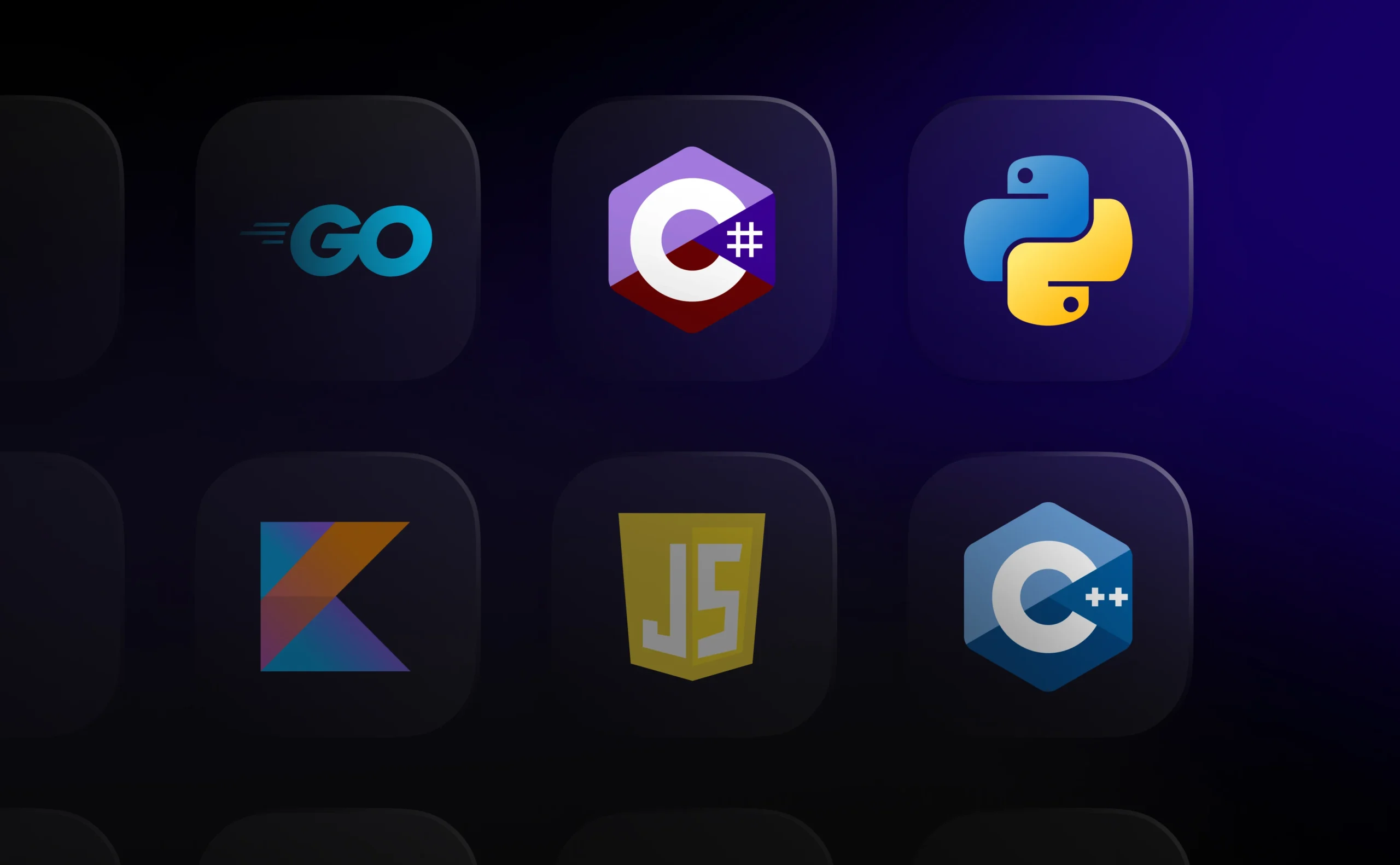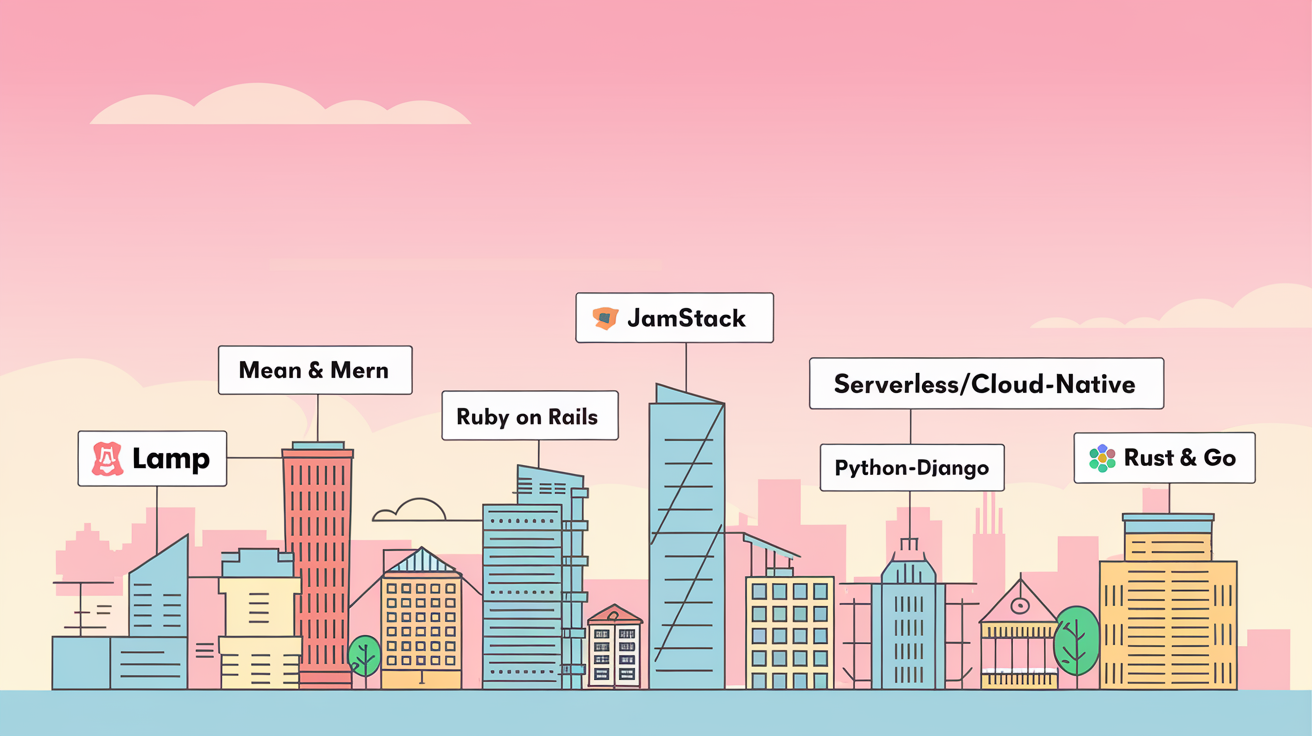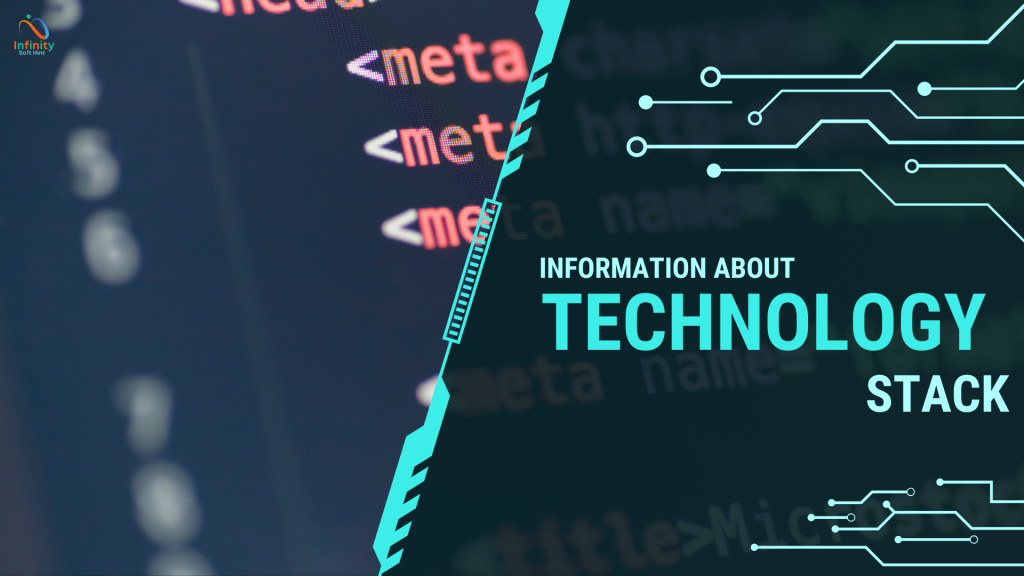Technology stacks, or “tech stacks,” are the unsung heroes of modern app and software development. Behind every sleek app interface or fast-loading website lies a carefully selected combination of tools, programming languages, and frameworks working in harmony. Choosing the right stack isn’t just a technical decision—it’s a strategic move that can dictate the success of your product.
In this guide, Explore the essentials of tech stacks, popular examples, and how to choose the one that’s right for your project. Whether you’re a software developer, CTO, or an IT enthusiast, this post will help you better understand the engine behind today’s innovative applications.
What is a Tech Stack?

Imagine building a house: you need a strong foundation, quality materials, and the right tools. A technology stack works the same way—it’s the collection of programming languages, frameworks, libraries, and tools developers use to create applications. Whether you’re crafting a sleek website, a mobile app, or enterprise software, your tech stack is the invisible engine that makes it functional, scalable, and future-proof.
Modern stacks are divided into two interconnected layers:
- Frontend (Client-Side): The user-facing interface—what people see and interact with.
- Backend (Server-Side): The behind-the-scenes logic, databases, and servers that power the app.
Frontend Technologies: Crafting the User Experience

The frontend is where creativity meets functionality. It’s the digital storefront that keeps users engaged.
Core Building Blocks
- HTML5: Structures content (think text, images, buttons).
- CSS3: Styles everything—animations, responsive layouts, dark mode.
- JavaScript: Adds interactivity (e.g., live chat, dynamic forms).
Modern Frameworks & Libraries
- React.js (Meta): Dominates with reusable components and a massive ecosystem. Used by Netflix and Airbnb.
- Vue.js (Community-Driven): Lightweight and flexible, perfect for startups.
- Angular (Google): Robust for enterprise apps (e.g., Gmail).
- Svelte: Rising star—compiles code upfront for blazing speed.
Power-Up Tools
- Vite: Replaces Webpack for faster builds.
- Tailwind CSS: Utility-first CSS for rapid design.
- TypeScript: Adds type safety to JavaScript (loved by 80% of devs).
Backend Technologies: The Brain Behind the Beauty

While the frontend dazzles users, the backend does the heavy lifting—data processing, security, and server management.
Popular Languages
- JavaScript/Node.js: Unify frontend/backend with one language (used by LinkedIn, PayPal).
- Python (Django/Flask/FastAPI): Ideal for AI-driven apps and rapid prototyping.
- Go (Golang): High-performance backend systems (think Kubernetes, Docker).
- Ruby on Rails: Still great for MVPs (e.g., Shopify’s early days).
Frameworks to Know
- Express.js (Node.js): Minimalist and lightning-fast.
- NestJS: TypeScript-friendly architecture for scalable apps.
- Spring Boot (Java): Enterprise-grade solutions (banks, airlines).
Servers & Deployment
- NGINX: Handles 30% of websites—perfect for high traffic.
- Caddy Server: Auto-HTTPS and simpler configs.
- Cloud Platforms: AWS, Google Cloud, and Vercel for serverless setups.
Databases: Where Data Lives

Your database choice depends on your app’s “personality”:
SQL (Structured Data)
- PostgreSQL: The Swiss Army knife—supports JSON, geodata, and more.
- MySQL: Battle-tested for e-commerce (think Shopify).
NoSQL (Flexible & Scalable)
- MongoDB: JSON-like documents for agile development.
- Firebase: Real-time data + authentication (popular for apps).
- Cassandra: Handles massive datasets (Netflix uses it).
Trendy Alternatives
- GraphQL: Fetch only the data you need (used by GitHub).
- Redis: Lightning-fast caching for high-traffic apps.
Popular Technology Stacks

Tech stacks are like recipes—combine the right ingredients (tools, languages, frameworks) to build apps tailored to specific needs. Here’s a breakdown of classic stacks still thriving and new contenders reshaping development today:
1. LAMP Stack
- Components: Linux, Apache, MySQL, PHP/Python
- Best For: Budget-friendly web apps, legacy system upgrades, or small businesses.
- 2023 Twist: While LAMP remains reliable, developers often replace PHP with Python (LAMP → LAPP) for modern scripting.
- Who Uses It? WordPress sites, local government portals, and startups prioritizing cost over scalability.
- Limitations: Struggles with real-time features and massive scaling.
2. MEAN & MERN Stacks
- MEAN Components: MongoDB, Express.js, Angular, Node.js
- MERN Components: MongoDB, Express.js, React, Node.js
- Best For: Full-stack JavaScript apps (from startups to enterprises).
- 2023 Upgrades:
- MEAN: Angular’s TypeScript support and Ivy engine boost performance.
- MERN: React + Next.js (for server-side rendering) dominates modern SaaS apps.
- MEVN: Swapping React for Vue.js gains traction in lightweight projects.
- Who Uses It?
- MEAN: Forbes, Upwork.
- MERN: Instagram (frontend), Airbnb.
3. Ruby on Rails
- Components: Ruby, Rails framework, PostgreSQL/MySQL.
- Best For: Rapid prototyping, MVPs, and developer happiness.
- 2023 Status: Still a startup darling (e.g., GitHub’s early days), but faces competition from Python and Node.js.
- Secret Sauce: Convention over configuration = less boilerplate code.
- Modern Pairings: Rails API + React/Vue frontends for SPAs.
4. JAMstack (Modern Static Sites)
- Components: JavaScript, APIs, Markup.
- Tools: Next.js, Gatsby, headless CMS (Strapi, Contentful), Vercel/Netlify.
- Best For: Blazing-fast blogs, marketing sites, and e-commerce (e.g., Nike, Shopify).
- Why 2023 Loves It: Security (pre-rendered HTML), scalability, and SEO-friendly.
5. Serverless/Cloud-Native Stack
- Components:
- Frontend: React/Vue + TypeScript.
- Backend: AWS Lambda/Google Cloud Functions.
- Database: Firebase/DynamoDB.
- Best For: Scalable apps with unpredictable traffic (e.g., TikTok, Netflix).
- Perks: Pay-as-you-go pricing, zero server management.
6. Python-Django Stack
- Components: Python, Django/Flask, PostgreSQL, React/Vue.
- Best For: Data-heavy apps, AI/ML integration, and FinTech.
- 2023 Momentum: Python’s dominance in AI (TensorFlow, PyTorch) keeps this stack relevant.
- Who Uses It? Instagram (backend), Spotify (data analysis).
7. Rust & Go Stacks (High-Performance)
- Components:
- Go: Gin/Echo frameworks, PostgreSQL, Kubernetes.
- Rust: Actix-web, Rocket, Svelte/React frontends.
- Best For: Microservices, real-time systems, and apps needing C-level speed with memory safety.
- Rising Stars: Used by Discord (Go), and Cloudflare (Rust).
Factors to Consider When Choosing a Tech Stack
Selecting the right tech stack isn’t just about picking popular tools. Consider these factors:
- Project Requirements: Define your app’s core needs—speed, scalability, or real-time capabilities.
- Scalability: Choose tools that grow as your user base expands.
- Security: Highly secure tech stacks are crucial for handling sensitive data.
- Budget: Open-source tools are often budget-friendly, yet it’s worth considering paid support or licensing costs.
- Skill Availability: Opt for tools your team knows or can learn quickly to reduce onboarding costs.
- Community Support: Larger, active communities provide better libraries, plugins, and troubleshooting resources.
Why Your Tech Stack Choice Matters: 7 Strategic Advantages

Picking the right tech stack isn’t just about coding—it’s a business decision that shapes your app’s success. Here’s how a well-chosen stack delivers value in 2023:
1. Accelerated Development & Time-to-Market
- Modern Tools = Less Boilerplate: Frameworks like Next.js (React) or Ruby on Rails cut repetitive coding by 40–60%, letting teams focus on unique features.
- Pre-Built Solutions: Leverage libraries (e.g., Stripe for payments) or low-code modules to skip reinventing the wheel.
- DevOps Integration: Stacks with built-in CI/CD pipelines (e.g., GitHub Actions + AWS) automate testing and deployment.
- Example: Startups like Clubhouse used React Native + Node.js to launch MVP apps in weeks.
2. Seamless Integration & Ecosystem Harmony
- APIs & Microservices: Modern stacks (e.g., MERN + GraphQL) simplify connecting third-party tools (Auth0 for login, Twilio for SMS).
- Cloud-Native Synergy: Tools like Firebase or Supabase bundle databases, auth, and hosting, reducing compatibility headaches.
- Avoid “Frankenstein” Systems: A cohesive stack prevents patchwork workflows (e.g., mixing Java backend with Python ML models without proper APIs).
3. High Performance & Scalability
- Real-Time Power: Stacks like Node.js + WebSockets or Elixir/Phoenix handle 1M+ concurrent users (e.g., WhatsApp, Discord).
- Edge Computing: Pair frameworks like SvelteKit or Remix with edge networks (Cloudflare Workers) for sub-100ms load times.
- Database Optimization: Match data needs to tools—Redis for caching, PostgreSQL for complex queries, or Snowflake for big data.
4. Cost Efficiency
- Open-Source Dominance: Stacks like LAMP (Linux, Apache, MySQL, PHP/Python) or JAMstack avoid licensing fees.
- Serverless Savings: Pay only for computing time (AWS Lambda) vs. maintaining idle servers.
- Talent Availability: Popular stacks (JavaScript, Python) have larger developer pools, reducing hiring costs.
5. Future-Proof Flexibility
- Modular Architecture: Stacks built with microservices (Go + Kubernetes) or headless CMS systems adapt to changing needs.
- Tech-Debt Avoidance: Choosing maintained frameworks (React over legacy jQuery) ensures long-term updates and security patches.
- AI Readiness: Python-centric stacks (Django + TensorFlow) simplify adding machine learning features later.
6. Enhanced Security
- Built-In Protections: Modern frameworks (Spring Boot, Laravel) include safeguards against SQLi, XSS, and CSRF attacks.
- Compliance-Friendly: Stacks like .NET + Azure offer GDPR/HIPAA-ready tools out of the box.
- Community Vigilance: Widely used tools (React, Django) have armies of developers patching vulnerabilities quickly.
7. Talent Retention & Developer Joy
- Modern Stacks Attract Top Devs: Engineers prefer working with trending tools (TypeScript, Rust) over outdated systems.
- Streamlined Workflows: Tools like Vite (frontend) or NestJS (backend) reduce frustration and burnout.
- Learning Ecosystems: Stacks with strong communities (React’s 18M+ npm downloads/week) offer endless resources for growth.
Real-World Impact
- Netflix: Switched to Node.js from Java, reducing startup time by 70%.
- Slack: Choose React + PHP/Hack for seamless real-time updates at scale.
- Doordash: Adopted Kotlin + Go microservices to handle 20M+ daily orders.
What’s Next for Tech Stacks?
Future trends for tech stacks lean towards automation and advanced analytics:
- Cloud-Native Tech Stacks: More businesses will migrate operations to platforms like AWS or Azure to scale globally.
- AI-Powered Solutions: AI-specific toolkits, such as TensorFlow or PyTorch, will merge with traditional stacks for smarter applications.
- Serverless Architectures: Technologies like AWS Lambda allow developers to build without worrying about infrastructure, optimizing costs for growing businesses.
Choosing the perfect tech stack will involve trade-offs between time-to-market, costs, and efficiency. But with the right insights, you can pick the combination that aligns with your business and technical goals.
Start exploring your ideal tech stack today and unlock high-performing applications with the right tools and strategies!
Choosing Your Stack: Key Questions
- Speed vs. Scale: Need an MVP fast? Try Rails or MERN. Building a microservices empire? Go + Kubernetes.
- Team Skills: A React-heavy team will thrive with MERN; Python pros should lean into Django.
- Community & Jobs: React/Angular have larger talent pools than Svelte or Rust.
- Future-Proofing: Stacks with TypeScript, GraphQL, or serverless architecture age better.
Conclusion
The technological stack underpins modern applications, offering structure, support, and innovation. Understanding and managing it can set you apart in a competitive market. You may build an app that exceeds user expectations by choosing the correct tools and frameworks.
Learning and adapting are essential during your technology adventure. Your technological stack should represent the vast, dynamic digital world.
Try numerous configurations to find the one that fits your aims and vision—a well-designed technology stack—the digital age’s unsung hero—powers every successful modern application.
FAQ’s
The modern technology stack incorporates new tools and frameworks to keep up with digital transformation. Flexible and versatile features enable easy adaptation to changing needs and industry norms.
Python’s adaptability and considerable library ecosystem appeal to many technology stack levels. Python is powerful for any stack aspect, from web frameworks like Django or Flask to data and machine learning packages like SciPy and TensorFlow.
Your project’s needs determine the optimum web development technology stack. The MERN or MEAN stack is suggested for fast web apps. Content-heavy or e-commerce sites may benefit from LAMP. Use tools that fit the job.
LAMP, a late-1990s technological stack, is the oldest. However, Linux and Apache, among other components of this stack, have a more extended history, demonstrating their durability and versatility.



